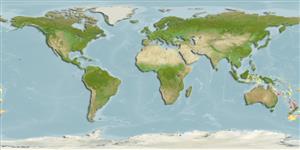>
Perciformes/Scorpaenoidei (Scorpionfishes) >
Triglidae (Searobins) > Pterygotriglinae
Etymology: Pterygotrigla: Greek, pterigion, diminutive of pteryx = wing, fin + Greek, trigla, es = red mullet (Ref. 45335).
Environment: milieu / climate zone / depth range / distribution range
البيئة
بحري قاعية المعيشة; نطاق العمق 333 - 630 m (Ref. 91768). Deep-water
Southwest Pacific: Australia, New Zealand and Norfolk I.
الحجم / وزن / العمر
Maturity: Lm ? range ? - ? cm
Found on the continental slope. Benthic (Ref. 75154).
Life cycle and mating behavior
Maturities | التكاثر | Spawnings | Egg(s) | Fecundities | Larvae
Paulin, C., A. Stewart, C. Roberts and P. McMillan, 1989. New Zealand fish: a complete guide. National Museum of New Zealand Miscellaneous Series No. 19. 279 p. (Ref. 5755)
IUCN Red List Status (Ref. 130435)
استخدامات بشرية
أدوات
تقارير خاصة
Download XML
مصادر علي الأنترنت
Estimates based on models
Preferred temperature (Ref.
123201): 6.7 - 11.5, mean 8.9 °C (based on 43 cells).
Phylogenetic diversity index (Ref.
82804): PD
50 = 0.5000 [Uniqueness, from 0.5 = low to 2.0 = high].
Bayesian length-weight: a=0.01259 (0.00515 - 0.03077), b=3.01 (2.79 - 3.23), in cm total length, based on LWR estimates for this (Sub)family-body shape (Ref.
93245).
مستوى غذائي (Ref.
69278): 3.6 ±0.5 se; based on size and trophs of closest relatives
المرونه (Ref.
120179): وسيط, الحد الزمني الأدني لتضاعف عدد أفراد المجتمع 1.4-4.4 سنة (Preliminary K or Fecundity.).
Fishing Vulnerability (Ref.
59153): Low vulnerability (14 of 100).
